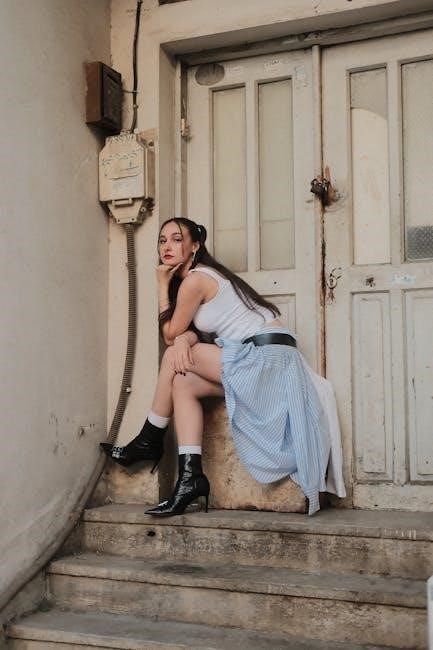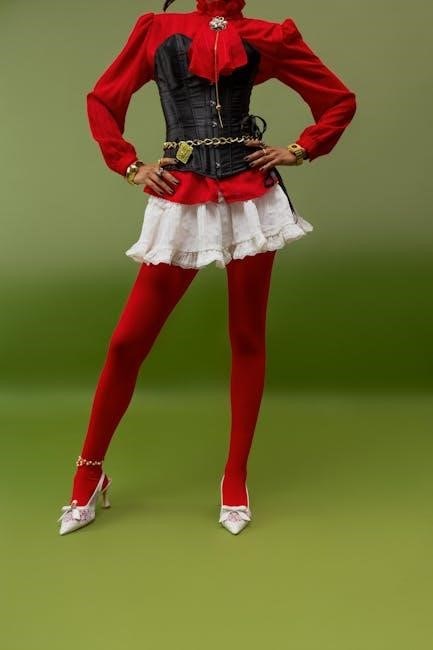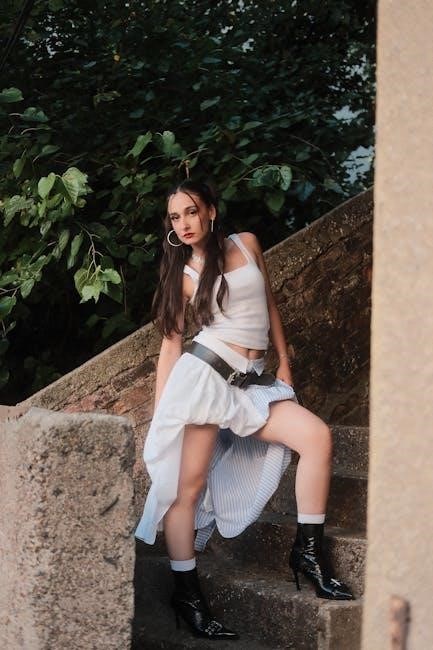Discover the essential role of BJJ belts‚ from personal preference to proper fit․ This guide helps you choose the right size‚ ensuring comfort and practicality for your training journey․
1․1 Importance of Proper Belt Size in BJJ
A properly fitting BJJ belt is crucial for both comfort and performance․ It ensures your gi stays securely tied during training‚ preventing distractions․ A belt that’s too tight can restrict movement‚ while one that’s too loose may come undone․ Proper sizing also supports hygiene‚ as a well-fitting belt is easier to clean and maintain․ Additionally‚ the right size enhances your training experience‚ allowing you to focus on techniques without adjustments․ Personal preference plays a role‚ but functionality should always come first to ensure optimal performance and confidence on the mat․
1․2 Overview of BJJ Belt Systems
The BJJ belt system is designed to provide a clear progression path for practitioners‚ with sizes ranging from A1 to A5․ These sizes correlate to the user’s weight and height‚ ensuring a proper fit․ While personal preference plays a role in belt length‚ the system offers a standardized guide to help practitioners choose the right size․ This guide is indispensable for ensuring comfort and practicality during training․ Understanding the belt system helps practitioners make informed decisions about their equipment‚ enhancing their overall BJJ experience․ Proper fit is key to both performance and hygiene‚ making the belt an essential part of BJJ training․
How BJJ Belts Work
BJJ belts are sized by weight categories (A1-A5) and designed to wrap twice around the waist․ Personal preference influences tightness‚ and washing can slightly reduce length for a better fit․
2․1 Understanding BJJ Belt Ranks
BJJ belts are categorized by size and rank‚ typically ranging from A1 to A5‚ corresponding to weight classes․ The belt size is determined by the practitioner’s waist measurement and personal preference․ While size charts provide a general guide‚ factors like comfort and desired tightness play a significant role․ Some prefer shorter belts for a snug fit‚ while others opt for longer ones to wrap multiple times․ Additionally‚ washing a belt can slightly reduce its length‚ allowing for a more tailored fit․ Understanding these dynamics helps in selecting the ideal belt for both training and competition settings․
2․2 Differences Between Adult and Youth Belts
Adult and youth BJJ belts differ primarily in size and design․ Adult belts are longer and wider‚ catering to larger waist sizes‚ while youth belts are shorter and narrower‚ tailored for younger practitioners․ Both follow similar size charts‚ but youth belts are designed for smaller body frames․ Material quality remains consistent across both categories‚ ensuring durability and comfort․ The key distinction lies in the length and fit‚ as youth belts are proportionally sized to accommodate growing athletes․ This ensures proper fit and performance for all age groups‚ making BJJ accessible and enjoyable for everyone․
Measuring for the Right Belt Size
Measure around your natural waistline with a flexible tape measure‚ ensuring a snug fit․ This ensures the belt stays secure during rolls and training sessions․
3․1 How to Measure Your Waist for a BJJ Belt
To measure your waist for a BJJ belt‚ locate your natural waistline‚ typically just above the hip bone․ Use a flexible tape measure and wrap it snugly around your torso without compressing your skin․ Ensure the tape measure is parallel to the floor for an accurate reading․ Note the measurement in inches or centimeters․ This measurement will serve as the basis for selecting the appropriate belt size․ For the most precise fit‚ consider measuring both with and without your gi to account for any differences․ Always refer to the manufacturer’s sizing chart‚ as belt lengths can vary slightly between brands․
3․2 Understanding Belt Length and Waist Size Correlation
Belt length is directly correlated with waist size to ensure a proper fit․ A longer belt isn’t always better; it should wrap around your waist snugly‚ with enough length to secure your gi but not so long that it’s cumbersome․ Generally‚ belt length ranges from 95 to 110 inches‚ corresponding to waist sizes from 24 to 40 inches․ This correlation ensures the belt stays in place during rolls and drills without restricting movement․ Proper sizing prevents discomfort and allows for effective training․ Always choose a belt that aligns with your measured waist size for optimal comfort and performance․

Factors Influencing Belt Size
Weight‚ height‚ and body composition influence belt size‚ with personal fit preferences and brand-specific measurements also playing a role to ensure optimal performance and comfort․
4․1 Weight and Height as Indicators
Weight and height are key indicators for determining BJJ belt size‚ as they correlate with waist circumference․ Taller individuals may require longer belts‚ while heavier practitioners might prefer wider or sturdier options․ Body composition also plays a role; muscular builds may need slightly larger sizes for comfort․ However‚ these are general guidelines‚ as personal preference and brand-specific sizing can vary․ Proper measurement ensures the belt stays secure during rolls without restricting movement․ Always consider these factors alongside direct waist measurements for the best fit․
4․2 Personal Preference in Belt Length
Personal preference plays a significant role in choosing BJJ belt length‚ as individuals may favor tighter or looser fits․ Some practitioners prefer a snug belt for better grip control‚ while others opt for a slightly longer length for comfort during movements․ Body type and training style also influence preferences; for example‚ taller or broader individuals might prefer longer belts․ Additionally‚ personal comfort and how the belt feels during rolls are crucial factors․ While guidelines provide a starting point‚ personal preference ensures the belt complements both performance and confidence on the mat․ It’s essential to find a balance between fit and comfort․

Common Belt Sizes and Their Uses
BJJ belts range from A0 to A5‚ catering to various waist sizes for optimal comfort and performance during training and competitions․
5․1 Standard Belt Sizes (A1 to A5)
Standard BJJ belt sizes range from A1 to A5‚ designed to accommodate different waist sizes․ A1 is the smallest‚ suitable for petite practitioners‚ while A5 is the largest‚ fitting taller or heavier athletes․ Each size increases in length and width‚ ensuring proper fit and comfort․ The most common sizes are A2 and A3‚ catering to average adult waistlines․ Correct sizing ensures optimal grip and movement during training․ Measuring your natural waistline accurately is key to choosing the right size․ Remember‚ belts may shrink slightly after washing‚ so consider this when selecting your size for the best fit․
5․2 Specialized Belt Sizes for Different Needs
Specialized BJJ belt sizes cater to specific requirements‚ such as youth belts for children or reinforced belts for heavy-duty training․ Youth belts are shorter and narrower‚ designed for smaller practitioners․ Competition belts are tailored to meet tournament regulations‚ often with precise length and width standards․ Additionally‚ some brands offer extra-long or extra-short belts for unique body types․ These specialized sizes ensure optimal fit and performance for diverse needs‚ whether for young athletes‚ competitive environments‚ or individuals with specific sizing requirements․ They provide comfort and functionality without compromising on quality or durability․
Choosing the Right Belt Material
Cotton belts are soft and breathable‚ ideal for comfort during training‚ while canvas belts offer durability and resistance‚ suitable for heavy use and competitions․

6․1 Cotton vs․ Canvas Belts
Cotton belts are soft‚ breathable‚ and lightweight‚ offering maximum comfort during training․ They are ideal for practitioners who prioritize flexibility and ease of movement․ Canvas belts‚ however‚ are more durable and resistant to wear‚ making them suitable for heavy training and competitions․ While cotton belts may stretch over time‚ canvas belts maintain their structure‚ providing consistent support․ The choice between the two often depends on personal preference‚ training intensity‚ and the need for longevity․ Both materials are widely used‚ but canvas is preferred for its resilience and performance under stress․
6․2 Deluxe and Competition-Grade Belts
Deluxe and competition-grade belts are designed for serious practitioners‚ offering superior quality and performance․ Deluxe belts often feature premium materials‚ such as heavy-duty canvas or reinforced stitching‚ ensuring durability and a professional look․ Competition-grade belts meet specific standards for thickness‚ weight‚ and dimensions‚ making them ideal for tournaments․ These belts are typically made from high-density materials that resist stretching and maintain their shape․ They are favored by competitors for their reliability and aesthetic appeal․ Both types are investments for those seeking long-term durability and a polished appearance‚ catering to both training and competitive demands․
Belt Care and Maintenance
Proper care ensures longevity and hygiene․ Regular washing and drying maintain cleanliness‚ while avoiding excessive heat prevents shrinkage or damage․ Prompt repairs prevent wear and tear․
7․1 Washing and Drying Your BJJ Belt
Regular washing is essential for hygiene․ Use mild detergent and cold water to avoid damaging the material․ Gently scrub stains‚ then rinse thoroughly․ Air-dry belts away from direct sunlight to prevent fading and shrinkage․ Avoid using fabric softeners or bleach‚ as they can weaken the fabric․ For tougher odors‚ soak the belt in vinegar solution before washing․ Never machine dry‚ as high heat can shrink or crack the belt․ Proper drying ensures the belt remains durable and comfortable for training․ Regular maintenance keeps your belt clean‚ fresh‚ and long-lasting․

7․2 How to Shrink or Adjust Belt Size
To shrink a BJJ belt‚ soak it in hot water for 30 minutes․ Gently scrub the material‚ then place it in a dryer on high heat for 10-15 minutes․ This method works best for natural fibers like cotton․ For synthetic belts‚ shrinking is less effective․ To adjust belt size‚ some practitioners prefer breaking it in gradually during training․ If a belt is too long‚ consider using a belt loop or wrapping it twice around the waist․ These methods ensure a secure fit without altering the belt’s integrity․ Always test adjustments carefully to avoid over-shrinking or damaging the material․

Belt Size for Training and Competition
Belt size varies between training and competition․ Training belts prioritize durability and comfort‚ while competition belts must meet specific size and weight regulations․
8․1 Belts for Daily Training
Choosing the right belt for daily training is crucial for comfort and performance․ Training belts are designed to withstand frequent use and washing․ Opt for durable materials like cotton or canvas‚ which provide a secure grip and lasting durability․ Belt length should fit snugly around your waist‚ allowing for a full range of motion․ A standard training belt is typically 4-5 cm wide‚ ensuring it stays in place during rolls and drills․ Proper sizing prevents excessive tightening‚ which can restrict movement․ Always consider your waist size and personal preference for tightness when selecting a training belt․
Additionally‚ a good training belt should be breathable to keep you cool during intense sessions․ Look for belts with reinforced stitching to handle the rigors of daily training․ Remember‚ the belt should feel like a second skin‚ providing support without discomfort․ By investing in a high-quality training belt‚ you ensure consistency and focus in your BJJ journey․
8․2 Belts for Tournaments and Competitions
For tournaments and competitions‚ choosing the right belt is essential for compliance and performance․ Competition belts must meet specific size and length regulations set by governing bodies like the IBJJF․ They are typically made from durable‚ high-grade materials to withstand rigorous use․ Opt for a belt that fits snugly and aligns with your weight class․ Proper sizing ensures fair competition and prevents disqualification․ Many competitors prefer thinner belts for better mobility‚ while others choose thicker ones for grip strength․ Always check tournament rules to ensure your belt meets all requirements‚ guaranteeing a smooth and confident performance on the mat․

Psychological Aspects of Belt Size
A BJJ belt’s size and color significantly impact a practitioner’s mindset‚ symbolizing progress and achievement․ It fosters motivation‚ confidence‚ and a sense of identity within the martial art․
9․1 Belt as a Symbol of Achievement
A BJJ belt serves as a powerful symbol of achievement‚ representing dedication‚ hard work‚ and mastery of techniques․ Each color signifies progress in the martial art‚ boosting morale and motivation․ Receiving a new belt is a milestone‚ acknowledging the practitioner’s journey and commitment․ It fosters a sense of pride and reinforces the effort invested in training․ The belt becomes a tangible reminder of growth‚ inspiring continued pursuit of excellence in Brazilian Jiu-Jitsu․
9․2 Belt Size and Confidence in Training
The right belt size plays a significant role in a practitioner’s confidence during training․ A properly fitted belt ensures comfort and stability‚ allowing focus on techniques without distractions․ Confidence is boosted when the belt feels secure‚ enabling smooth transitions and movements․ A belt that is too tight or too loose can hinder performance and lower self-assurance․ Personal preference in belt size also matters‚ as it directly impacts how practitioners feel during rolls and drills․ A well-fitted belt enhances mental preparedness‚ fostering a positive and confident mindset essential for progressing in BJJ․
Selecting the right BJJ belt size is crucial for comfort‚ performance‚ and confidence․ Proper fit ensures optimal training and represents achievement in your martial arts journey․

10․1 Final Tips for Choosing the Perfect BJJ Belt
When selecting a BJJ belt‚ prioritize material quality and accurate sizing․ Cotton belts are durable and comfortable for daily training‚ while canvas belts are stiffer and ideal for competitions․ Ensure your belt fits snugly without being too tight‚ as this can restrict movement․ Consider the thickness—thinner belts are easier to grip‚ while thicker ones offer more durability․ Personal preferences‚ such as color and design‚ also play a role․ Ultimately‚ choose a belt that balances comfort‚ functionality‚ and personal style to enhance your training experience and represent your dedication to the sport․
10․2 Importance of Comfort and Practicality
Comfort and practicality are crucial for optimal performance in Brazilian Jiu-Jitsu․ A well-fitting belt ensures unrestricted movement and prevents distractions during training․ It should be snug but not overly tight to avoid discomfort․ The material and design should be durable to withstand rigorous use․ A practical belt is easy to maintain and clean‚ reducing maintenance downtime․ Prioritizing comfort and practicality enhances focus and training efficiency‚ allowing practitioners to concentrate on technique and progression without being hindered by their gear․ Investing in a high-quality‚ comfortable belt is a wise decision for any serious BJJ practitioner․

Additional Resources
Explore official federation websites‚ tutorial videos‚ and forums for more insights․ Training guides and community discussions offer valuable tips for choosing and maintaining your BJJ belt․
11․1 Recommended BJJ Belt Brands
Top-tier brands like Gracie Barra‚ Atama‚ and 95Lab offer durable‚ high-quality belts․ Tatami and Scramble provide stylish‚ functional options․ For premium belts‚ consider Gameness or Invert Gear․ These brands ensure comfort‚ longevity‚ and IBJJF compliance․ Many practitioners also praise Sanabul and Elite Sports for their affordable yet reliable belts․ Researching reviews and product descriptions can help you find the best fit for your training needs and preferences․ Always check sizing charts to ensure the perfect match for your BJJ journey․

11․2 Where to Buy High-Quality BJJ Belts
High-quality BJJ belts can be purchased from reputable retailers like Amazon‚ eBay‚ and specialty martial arts stores․ Brands like Gracie Barra and Atama often sell directly through their official websites․ Additionally‚ local martial arts shops or BJJ gyms may carry a selection of belts․ For authenticity and quality‚ consider buying from trusted brands or their authorized distributors․ Online marketplaces offer convenience‚ while specialty stores provide personalized service․ Always ensure the belt meets IBJJF standards for competitions․ Remember to check reviews and sizing charts before making a purchase to ensure the best fit for your training needs․